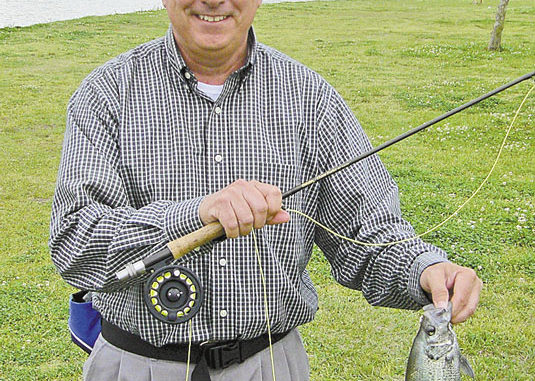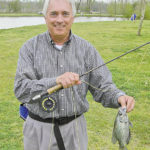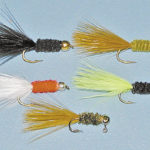
We’ve had an unusually cold winter. Where’s global warming when we need it most? The Nobel Committee should demand that Al Gore give his prize back.It’s been so cold that large mammals have migrated south from Canada. My sister’s bank has been renamed to “Peoples and Mooses Bank of Opelousas.”
Then there was the problem of fishing through the ice. I had a hard time finding an auger.
Good news is that water temperatures are on the rise. They sure have a long way to go. But by the end of this month, some species should be getting active.
One of those will be crappie.
Whether you live in the southern parishes and call them ‘sac-a-lait,’ or live in the northern parishes and call them ‘white perch,’ I think we can all agree to call them ‘delicious.’
I always practice catch-and-release with sac-a-lait. If they’re under 10 inches, I release them to the water. Otherwise, I release them into my ice chest.
There are many good flies for white perch: Woolybuggers, Crappie Candies, Gummy Minnows, small Clousers and Charlies. In fact, just about anything that resembles a minnow or shad will work.
But one fly is definitely my favorite.
The Fluff Butt is a somewhat ubiquitous pattern, as it’s true origins are the crappie jigs that consist of a chenille body and a marabou tail. However, Mark Hester of Baton Rouge, a specialist at crappie on the fly, is given credit for the name and the popularization of the fly version.
In the late 1980s, Hester was tying the Butt on tiny 1/100-ounce jigheads. The flies could get deep in a hurry. But they weren’t easy to cast on something like a 3-weight rod. That’s the fun of sac-a-lait in our sport — catching them on light weight rods.
A few years later, during a presentation to our club, Hester made the point that the jighead not only added weight to the fly; more importantly it allowed the fly to swim horizontally.
An alternative was suggested that night, thanks to a member who had a copy of a British-based fly fishing magazine titled “Stillwater Trout Angler.”
Stream fishing in England has the reputation of fine-dressed gentlemen adhering to a strict etiquette. Lake fishing is a whole different story.
Every issue of that magazine revealed new heresies to our sport. In this particular issue, the controversy was beads on flies.
Beadhead flies originated in Italy during the late 1980s. Roman Moser of Germany, one of the most innovative tiers of the time, soon began applying beads to traditional nymph patterns. Their use — and their success — quickly spread across Europe.
It wasn’t until 1993, in an article by Tom Rosenbauer in Fly Fisherman magazine, that most American anglers became aware of the use of beads on flies. By then, the beadhead version of the Fluff Butt was already established.
Over the years, many variations of the Butt have evolved, just as they have for the Clouser Minnow, the Charlie, the Woolybugger and other great flies.
The Peterson Butt uses a body of metallic braid in lieu of chenille. In the last year, I’ve seen the marabou tail replaced by iceabou and other synthetic marabou materials to add as much sparkle to the tail as the body has.
The Epoxy Butt, better known as the E-Minnow, is a variation of the Peterson Butt. It has a braided metallic body, and a flashabou strand on each side from eye to end of tail. Most important, the body is coated over with a thin epoxy that really makes it attractive.
The Coma Minnow — my own creation — probably deviates the most. I use ice chenille in lieu of chenille for the body, and mylar for the tail.
I could name at least a dozen more variations of this fly. No coincidence that most of their creators live in Texas, Louisiana or Mississippi. This is the best region of the country for crappie, and this is one heck of a minnow imitation for catching this fantastic species. U
Tying the Fluff Butt
If you know how to tie a Woolybugger, then good news! The Fluff Butt is just the same, but without the hackle feather.
Start with a Mustad 9672 hook (or similiar), either size 10 or 12. Crush the barb, and bend the hook down just enough to pass a 1/8-inch bead up the point and to behind the eye. Then bend the hook back. Wrap a thread base on the shank.
Pick a strand of strung marabou for the tail. Before tying it on, measure it. The tail should be as long as the hook shank. Do not trim the strand — tie it in first. Secure it with thread from above the barb to behind the bead. Trim off the end of the marabou just behind the bead.
Next, tie in the tip of a section of fine chenille (or ultra chenille, vernille, metallic braid, etc.) right where the thread ends and the tail begins. Wrap the chenille around the hook, each layer against the other, toward the eye. When you reach the bead, cross the thread over the chenille a couple of times.
Trim the chenille off, then tie in a half-hitch or whip finish knot. Add a drop or two of flexament or other adhesive to keep the knot intact, and you’re done.




